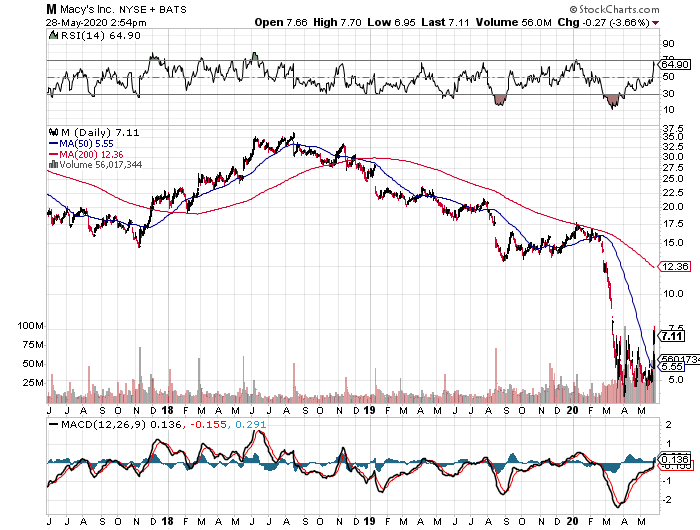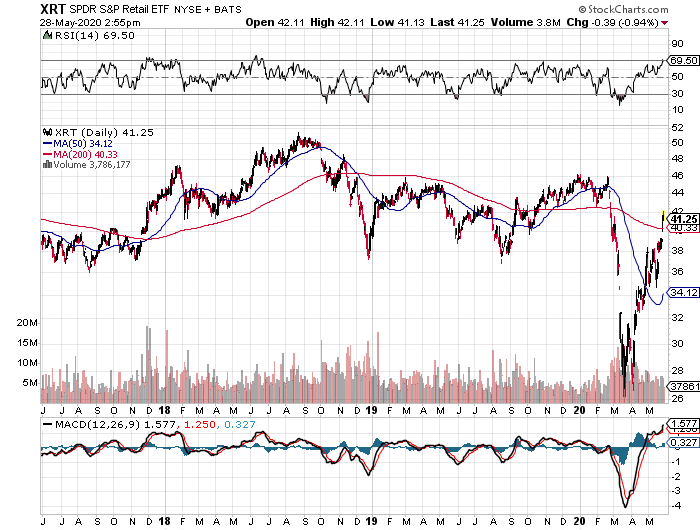If you had to pick the biggest loser of our ongoing pandemic and the trade wars, it would be the retail industry (XRT). Higher costs which can’t be passed on, rising minimum wages, lower selling prices, and a massive inventory glut is not what money-making is all about.
Now, take all of those problems and drop your revenues by half, thanks to the pandemic. A future where touching, feeling, and trying on things before you buy them is about to become an extravagant luxury.
The stocks have delivered as expected, providing one of the worst-performing sectors of the past three years. Half of them probably won’t even make it until Christmas.
In fact, Sears and Macy’s have announced more store closings nationwide. The overhead is killing them in a micro margin world devoid of window shopping customers.
So, I stopped at a Walmart (WMT) the other day on my way to Napa Valley to find out why.
I am not normally a customer of this establishment. But I was on my way to a meeting where a dozen red long stem roses would prove useful. I happened to know you could get these for $10 a dozen at Walmart, 60% cheaper than anywhere else.
After I found my flowers, I browsed around the store to see what else they had for sale. The first thing I noticed was that half the employees were missing their front teeth.
The clothing offered was out of style and made of cheap material. It might as well have been the Chinese embassy. Most concerning, there was almost no one there, customers OR employees.
The Macy’s downsizing is only the latest evidence of a major change in the global economy that has been evolving over the last two decades.
However, it now appears we have reached both a tipping point and a point of no return. The future is happening faster than anyone thought possible. The pandemic has forced business evolution to move at hyper fast forward and the Death of Retail is no exception.
I remember the first purchases I made at Amazon 20 years ago. I personally knew the founder, Jeff Bezos, from my Morgan Stanley days. The idea sounded so dubious that I made my initial purchases with a credit card with only a low $1,000 limit. That way, if the wheels fell off, my losses would be limited.
And how stupid was that name, Amazon, anyway? At least he didn’t call it “Yahoo” because it was already taken.
Today, I do almost all of my shopping at Amazon (AMZN). It saves me immense amounts of time while expanding my choices exponentially. And I don’t have to fight traffic, engage in the parking space wars, or wait in line to pay.
It can accommodate all of my requests, no matter how bizarre or esoteric. A WWII reproduction Army Air Corps canvas flight jacket in size XXL? No problem!
A used 42-inch Sub Zero refrigerator with a front door ice maker and water dispenser? Have it there in two days, with free shipping at one fifth the $17,000 full retail price.
So I was not surprised when I learned that Amazon accounted for 25% of all new online sales in 2019 in a market that is already growing at a breathtaking 20% YOY.
In 2000, after the great “Y2K” disaster that failed to show, I met with Bill Gates Sr. to discuss his foundation’s investments.
It turned out that they had liquidated their entire equity portfolio and placed all their money into bonds. It turned out to be a brilliant move, coming mere months before the Dotcom bust and a 20-year bull market in fixed income which only peaked two months ago.
Mr. Gates (another Eagle Scout) mentioned something fascinating to me. He said that unlike most other foundations their size, they hadn’t invested a dollar in commercial real estate. Today, that looks like a prescient move in the extreme with 60% of mall tenants skipping their rent.
It was his view that the US economy would move entirely online, everyone would work from home, emptying out city centers, and rendering commuting unnecessary. Shopping malls would become low rent climbing walls and paintball game centers.
Mr. Gates’ prediction may finally be occurring. In the San Francisco Bay area, the only employed people are those who are telecommuting.
Even before the pandemic, it was common for staff to work Tuesday-Thursday at the office, and from home on Monday and Friday. Productivity increases. People are bending their jobs to fit their lifestyles. And oh yes, happy people work for less money in exchange for personal freedom, boosting profits.
The Mad Hedge Fund Trader itself may be a model for the future. We are entirely a virtual company, with no office. Everyone works at home in four countries around the world. Oh, and we all use Amazon to do our shopping.
The downside to this is that whenever there is a snowstorm anywhere in the country, it affects our output. Two storms are a disaster, and at three, such as last winter, we grind to a virtual halt.
The main thing I am worried about is the Internet in the Philippines which is unable to handle the tenfold increase in demand since the start of the pandemic. They don’t have our infrastructure. If you wonder why your customer support at any company has suddenly gotten poor, that is the reason.
You may have noticed that I can work from anywhere and anytime (although sending a Trade Alert from the back of a camel in the Sahara Desert was a stretch), so was sending out an Alert while hanging on the cliff face of a Swiss Alp. But they both made money.
Moroccan cell coverage is better than ours, but the dromedary’s swaying movement made it hard to hit the right keys.
The cost of global distribution is essentially zero. Profits go into a bonus pool shared by all. Oh, and we’re hiring, especially in marketing.
It is happening because the entire “bricks and mortar” industry is getting left behind by the march of history.
Sure, they have been pouring millions into online commerce and jazzed up websites. But they all seem to be poor imitations of Amazon, with higher prices and worse service. It is all “hour late and dollar short” stuff.
In the meantime, Amazon has soared by an eye-popping 56% since the March 23 low and is one of the top-performing big-cap stocks of 2020. There is now a cluster of Amazon analyst forecasts targeting the $3,000 mark, including me.
And here is the bad news. Bricks and Mortar retailers are about to lose more of their lunch to Chinese Internet giant Alibaba (BABA), which is ramping up its US operations and is FOUR TIMES THE SIZE OF AMAZON!
There’s a good reason why you haven’t heard much from me about retailers. I made the decision 30 years ago never to touch the troubled sector.
I did this when I realized that management never knew beforehand which of their products would succeed and which would bomb, and therefore, were constantly clueless about future earnings.
The business for them was an endless roll of the dice. That is a proposition in which I was unwilling to invest. There were always better trades.
I confess that I had to look up the ticker symbols for this story, as I never use them.
You will no doubt be enticed to buy retail stocks as the deal of the century by the talking heads on TV, Internet research, and maybe even your own brokers, citing how “cheap” they are because the prices are so low.
Never confuse a low stock price with “cheap.”
It will be much like buying the coal industry (KOL) a few years ago, another industry headed for the dustbin of history. That was when “cheap” was on its way to zero for almost every company. Don’t buy the next coal company.
So the next time someone recommends that you buy retail stocks, you should probably lie down and take a long nap first. When you awaken, hopefully the temptation will be gone.
Or better yet, go shopping at Amazon. The deals are to die for.
To read “An Evening with Bill Gates Sr.,” please click here.




